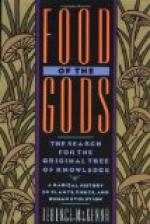It certainly behoves us, therefore, to learn something more of such a valuable article than may be gleaned from the perusal of an advertisement, or the instructions on a packet containing it. There is something more than usually fascinating even in its history, in all the tales regarding this treasure-trove of the New World, and in the curious methods by which it has been treated. The story of its discovery takes us into the atmosphere of the Elizabethan period, and into the company of Cortes and Columbus; to learn of its cultivation and preparation we are transported to the glorious realms of the tropics, and to some of the most healthful centres of labour in the old country—in one case to the model village of the English Midlands. It is therefore an exceedingly pleasant round that lies before us in investigating this subject, as well as one which will afford much useful knowledge for every-day life.
Before proceeding to a closer acquaintance with the origin of cocoa, it may be well to clear the ground of possible misconceptions which occasionally cause confusion.
[Illustration—Drawing: The coco-nut palm.]
First, there is the word “cocoa” itself, an unfortunate inversion of the name of the tree from which it is derived, the cacao.[4] A still more unfortunate corruption is that of “coco-nut” to “cocoa-nut,” which is altogether inexcusable. In this case it is therefore quite correct to drop the concluding “a,” as the coco-nut has nothing whatever to do with cocoa or the cacao, being the fruit of a palm[5] in every way distinct from it, as will be seen from the accompanying illustration.
[Illustration—Drawing: Coco-de-mer.]
The name “coco” is also applied to another quite distinct fruit, the coco-de-mer, or “sea-coco,” somewhat resembling a coco-nut in its pod, but weighing about 28 lbs., and likewise growing on a lofty tree; its habitat is the Seychelles Islands. Sometimes also, confusion arises between the cacao and the coca or cuca,[6] a small shrub like a blackthorn, also widely cultivated in Central America, from the leaves of which the powerful narcotic cocaine is extracted.
[Illustration—Drawing: Leaves and flower of the cuca shrub.]
In the second place, the name “cocoa,” which is strictly applicable only to the pure ground nib or its concentrated essence, is sometimes unjustifiably applied to preparations of cocoa with starch, alkali, sugar, etc., which it would be more correct to describe as “chocolate powder,” chocolate being admittedly a confection of cocoa with other substances and flavourings.
[Illustration—Black and White Plate: Gathering Cacao: Santa Cruz, Trinidad.]




